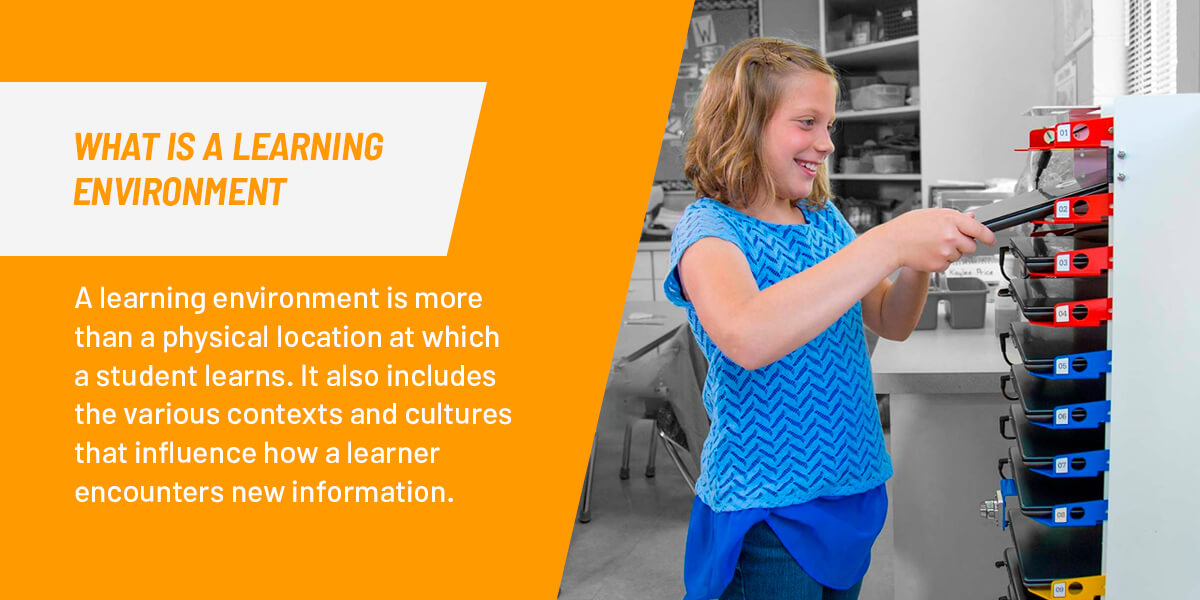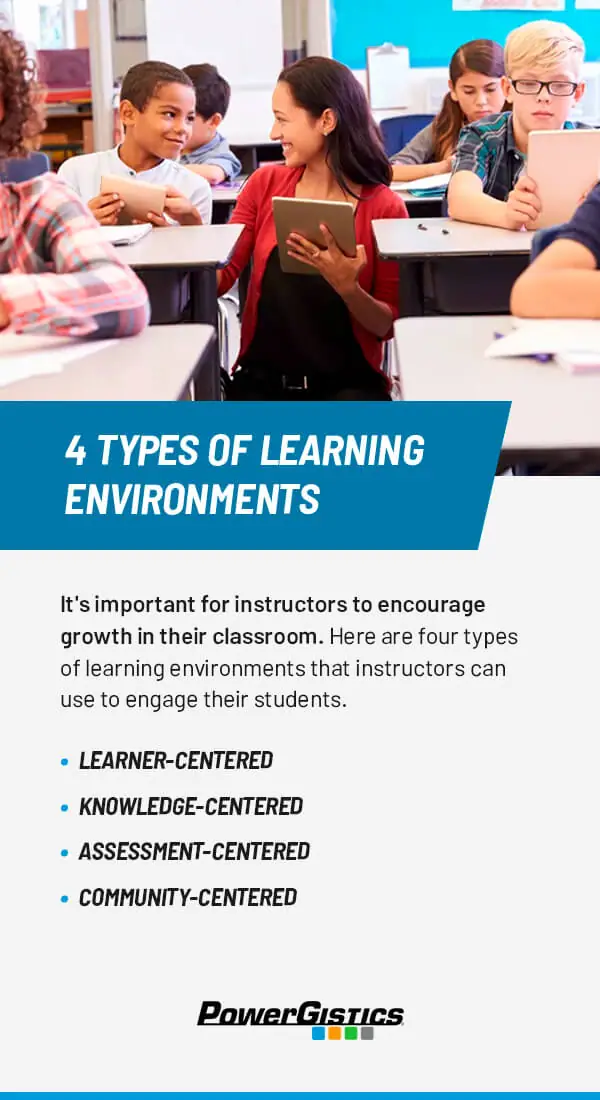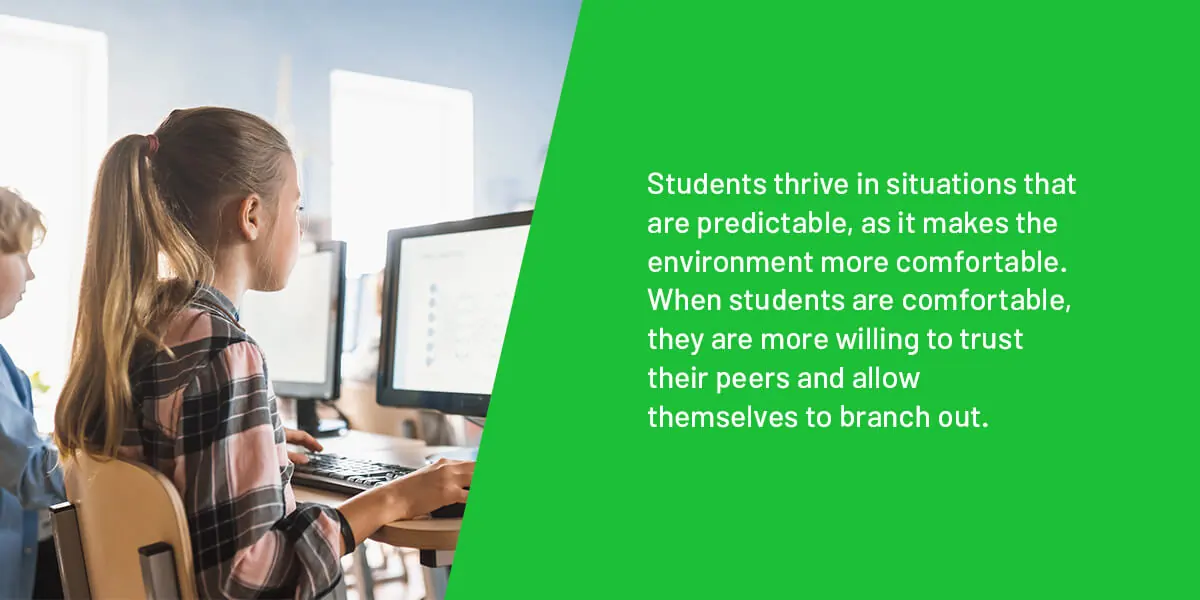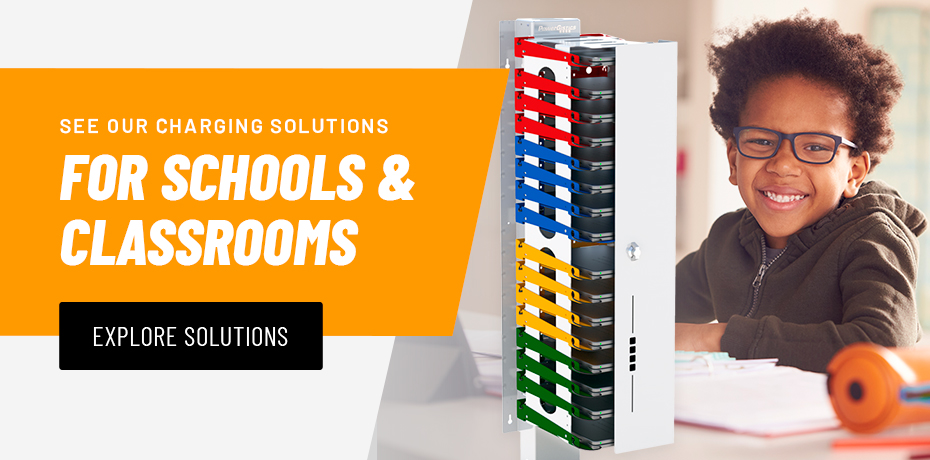How Teachers Can Create Highly Effective Learning Environments
December 3, 2021
Many teachers are looking for ways to keep their students engaged. However, the traditional teacher-centered classroom instruction methods are proving ineffective for many students. It is difficult for students to remain engaged when their various needs are not met, so teachers are developing alternative methods to encourage student participation and development.
The best way to create an effective learning environment is by knowing your students and their needs. We have compiled resources to help you facilitate learning in an impactful way for your students.
What Is a Learning Environment?
A learning environment is more than a physical location where a student learns. It also includes the various contexts and cultures that influence how a learner encounters new information. It includes locations outside of the designated classroom, including libraries or outdoor environments.
“Learning environment” also refers to how an instructor organizes a class or presents the educational material. By incorporating the ways that individuals interact with each other, the phrase allows a more comprehensive understanding of the learning environment for both students and teachers.
The definition of a learning environment acknowledges that students learn differently, especially depending on the context. The best learning environment for one student may differ greatly from that of their peer.

4 Types of Learning Environments
There are four distinct educational environments instructors can use to engage students.
1. Learner-Centered
A learner-centered learning environment, or a student-centered environment, focuses on the qualities that students bring with them to the classroom. This learning environment allows students to decide what kind of material they learn and how they learn it. This differs from teacher-centered learning environments, where the instructor makes all the decisions. Learner-centered environments do not eliminate the essential role of the teacher — they rely on the teacher’s knowledge and expertise to increase student engagement.
Learner-centered environments strengthen students’ decision-making skills by using them as a strong force for the learning process. This environment can look different across classrooms, but most student-centered environments have some features in common. These environments emphasize how the educational process applies to the world outside of the classroom. This makes the material more widely applicable to the learner’s life and presents itself as transferable knowledge. Many programs with this environment also include rigorous assessments of students and teachers to determine their performance.
2. Knowledge-Centered
Knowledge-centered learning environments prioritize the diversity of information that a student learns. The goal is to help them learn things in a wide range of academic disciplines, equipping learners with a broad understanding of a balanced array of subjects. The knowledge-centered curriculum is carefully organized to gradually increase in complexity over time. As the curriculum becomes more challenging, students develop a more specialized understanding of topics in a specific subject.
Because this curriculum requires in-depth information about a subject, instructors who are experts in the discipline teach the class. Knowledge-based curricula naturally sequence to help learners develop a map of information that is easily remembered, rather than memorizing it and regurgitating it onto an assessment.
3. Assessment-Centered
Assessment-centered learning environments emphasize the importance of feedback for learners and teachers. This curriculum uses two main kinds of assessments:
- Formative: Formative assessments help instructors establish what students already know about a subject. The feedback from these assessments gives students direction for understanding what aspects of a topic they need to continue studying for a comprehensive grasp on the topic. Instructors administer these assessments regularly to give feedback on progress up to that point.
- Summative: At the end of a unit, an instructor administers a summative assessment to determine how well students understand and apply the material from the instructional unit.
4. Community-Centered
Community-centered learning environments encourage collaboration among learners. The most important element of a community-centered environment is a strong basis of trust among the students and the instructor. This environment prioritizes the importance of allowing students to make mistakes in the classroom without worrying about potential negative repercussions. Students who feel comfortable making mistakes in the classroom are more engaged, helping them learn.
This environment implements assignments that prioritize collaboration over competition. Courses that encourage critical thinking and problem-solving allow students to work together to come to conclusions as a group. This encourages them to participate more actively and avoid the fear of failure or ridicule once trust has been established in the classroom.

Characteristics of a Learning Environment
Although there are various types of effective learning environments to implement in a classroom, they all share some components that reinforce the value of an instructor.
1. Safety
An environment that encourages learning makes students feel safe. A safe space influences the culture of a classroom because students who know they are safe are more trusting and willing to participate. A safe space is one that makes students feel accepted.
Emotional safety gives students the space to make mistakes without fear of ridicule or failure. Feeling accepted by an instructor and their peers encourages students to push the boundaries of their comfort zone and experiment creatively, producing higher-quality performance.
Trust and security are two sides of the same coin. A safe space ultimately allow students to feel more connected to each other, which encourages collaboration and participation in the classroom.
2. Positivity
Learning environments require positive feedback. When reviewing an assessment, students should not only learn from the mistakes they made but also feel proud of the successes they had. Turning mistakes into learning opportunities establishes a culture where students are satisfied with work they complete. Positive reinforcements encourage students to continue their efforts, whereas humiliation can deter them from wanting to try again.
Students are part of the learning environment, so the classroom runs much more effectively when they assist the instructor in motivating their peers. When the instructor sets a good example of how to respond to situations that could be embarrassing, like answering a question incorrectly, it serves as an invitation to the other students to act similarly. By enforcing compliance with motivational and positive behaviors, the culture of a classroom is much more conducive to learning.
3. Diversity of Perspectives
To create an effective learning environment, an instructor must acknowledge the strengths that students bring to the classroom, including their ideas and perspectives. Learning environments encourage the individuality of each student while also emphasizing the importance of using their skills to contribute to the greater community in the classroom. By practicing this approach, students learn that their contributions are valuable in professional and personal situations, and a culture of collaboration is fostered.
It’s important to allow students to share their perspectives with varied groups of their peers. While everyone’s ideas and thoughts are valuable, working with the same group of people for long stretches of time can stagnate growth and development.
4. Interactive Opportunities
The traditional teacher-centered learning environment requires students to participate in a classroom culture that is not tailored to fit their needs. Active learning environments are much more engaging than the passive learning of the past. Invite students to participate in classroom activities by offering opportunities that are easy to participate in. Small-group activities and non-competitive games can break down cliques or help shy students meet new people. These classroom opportunities encourage communication and collaboration among peers, which helps establish an effective learning environment.
Interacting with instructional material in multiple ways also helps students learn. Allow students to engage with information in a variety of ways, as most students are a combination of auditory, kinesthetic and visual learners. This helps students retain information better than if they only employed one of these methods.

How Can Teachers Create Effective Learning Environments?
Educators can implement the following steps to cultivate a positive learning space in their classrooms:
1. Allow Students to Feel Heard and Valued
Encourage open communication so students feel like their thoughts matter and they can comfortably engage in meaningful discussions. Of course, it’s important to remind students of best practices for polite and respectful conversation, like raising their hands before speaking and not talking over one another. That way, everyone can answer questions and share their thoughts.
Here are some ways to boost engagement and create a more collaborative classroom environment:
- Collect feedback. Have students complete surveys and provide anonymous feedback on the course material. Try to implement these improvement opportunities, if possible, to show that you value their input. This strategy can reveal obstacles hindering students’ learning or sense of belonging, helping them feel more seen and understood.
- Personalize lessons. Tailoring your course material to students can motivate them to participate and make them feel included. Say you’re developing a sample response to a writing prompt. You can include a student’s name and a hobby they enjoy.
- Refrain from “right” answers. Invite conversations that encourage critical thinking instead of general consensus. Have students share their perspectives and consider different viewpoints.
2. Integrate Positive Reinforcement
Positive reinforcement encourages the repetition of desired behaviors by rewarding students for exhibiting these behaviors. Teachers can use this strategy to create a supportive learning environment, promoting positive attitudes and work habits. Consider these examples:
- Verbal and written praise: When students exhibit positive behaviors or complete tasks successfully, compliment them verbally or write them a note with encouraging comments and a sticker.
- Behavior punch cards: Punch these cards with a hole punch each time students complete a desired behavior. After all the slots have been punched, give the student a small reward and a new punch card to set another goal.
- Prize boxes: Fill a box with trinkets like yo-yos, stickers, pencils, erasers, bouncy balls and mini bubble wands. Allow students to select an item from the prize box as a reward for good behavior.
3. Create an Inclusive Learning Environment
Help students feel valued and supported by embracing different perspectives and learning methods. Here are some ways to do so:
- Incorporate various teaching methods. Implement strategies that cater to multiple preferences and abilities, like small- and large-group discussions, lectures, writing exercises, interactive games, educational technology and think-pair-share.
- Make course materials inclusive. Choose course content that speaks to students’ diverse identities, perspectives, experiences and skills.
- Allow options for completing assignments. Offer multiple modes to complete assignments — like papers, presentations and posters — to appeal to different learning preferences. Enable opportunities for traditional, virtual, individual and group work.
4. Keep Students Informed and Updated
To create an effective learning environment, the instructor should equip students with the tools they need to succeed. This includes being aware of the resources that are available to them, such as libraries and learning centers. Here are some ways to keep students informed:
- Involve parents. Connecting with parents can open up avenues for helping students learn even when they are out of the classroom. Parents can offer a strong support system to the students, from homework help to positive reinforcement.
- Share information consistently. Effective learning environments ensure that students have access to the necessary materials and information. Consider what educational information needs to be posted on the walls, such as vocabulary words, relevant formulas or purposeful posters and bulletin boards. Clearly share the date, upcoming assignments and classroom procedures, especially those decided upon by the students themselves.
5. Plan Your Classroom Layout Strategically
Students need to feel comfortable in the classroom to ensure an effective learning environment. To encourage a sense of belonging, create a welcoming space that doesn’t feel stale or generic. Give students a feeling of ownership over the space by displaying their work. Ask for their input on the classroom layout to involve them in the process of creating a classroom that makes them feel like active participants.
Here are some best practices for classroom layout planning:
- Designate specific areas. The classroom layout plays a crucial role in creating an effective learning environment. Both the students and the instructor should have dedicated areas they call their own. A teacher’s area offers a place to rest while students are working on assignments or taking exams. By having a specific teacher area, students can easily access help or ask questions if needed. When students have an individual desk or table space, they are more likely to keep it tidy.
- Arrange desks strategically. The physical space influences how students interact with each other. Arranging the desks in a classroom contributes to an effective learning environment. For example, if you place the desks in clusters of four, it’s easier for students to communicate with each other. For large-group activities, placing desks in a manner that allows them to easily see everyone in the room helps keep them engaged in the group-wide discussion.
- Prioritize accessibility. Consider accessibility for students and yourself when creating your classroom layout. You should be able to reach every desk in the classroom to monitor and assist students. Focusing on accessibility goes hand in hand with safety — students should be able to navigate the classroom without disrupting others or hurting themselves.
- Leverage storage solutions. Facilitate easy traffic flow by using effective storage solutions. If technology available to students is stored in your classroom, utilize a smart storage option to ensure that students can easily access what they need. Other materials, like paper or writing utensils, should be kept in areas that are easy for students to return them after use.
Importance of an Effective Learning Environment
An effective learning environment benefits both teachers and students. Instructors create a culture of trust, which increases engagement and facilitates learning. Increasing the variety of instruction methods keeps teaching interesting, as you avoid the redundancy of lectures every day.
Students benefit greatly from an effective learning environment both academically and developmentally. Students learn and understand the importance of boundaries. The teacher has a designated area, and the students have specific spaces over which they claim ownership and responsibility.
Learning environments also establish predictability, as students can anticipate which kinds of activities occur in dedicated areas. They understand what kinds of behaviors are accepted and expected when in different locations in and out of the classroom, so they are attentive to how they can act during activities without causing a distraction. Students thrive in situations that are predictable, as it makes the environment more comfortable. When students are comfortable, they are more willing to trust their peers and branch out.
Effective learning environments familiarize students with various resources available to them in and out of the classroom. They can easily find classroom materials with a proper classroom setup or ask for help from groups that are designed specifically for aiding them. When students understand the need that a specific area fulfills, they can more easily take advantage of it.
Enhance Your School’s Learning Environment With Technology Charging Solutions From PowerGistics
Create an effective learning environment by managing the technology in your classroom. PowerGistics offers alternatives to the large, bulky laptop carts that can inhibit traffic flow and take up valuable space. Easily organize cords to charge technology and avoid accidents — even for young students — with the horizontal shelves.
Your school can save money and hold a lifetime warranty on these versatile Towers that protect and organize valuable technology. Request more information about PowerGistics and our products using our contact form!

